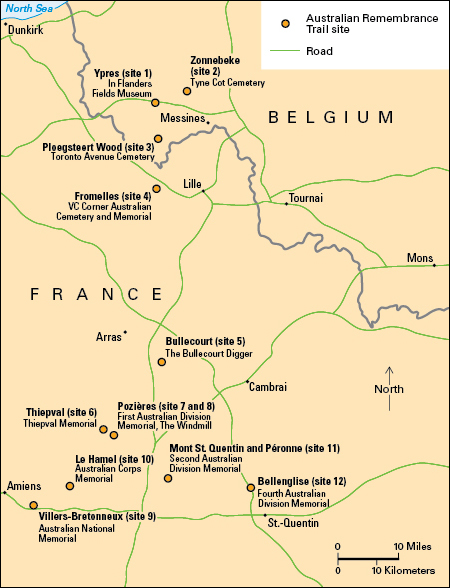Australian Remembrance Trail is a series of sites that traces Australian involvement on the Western Front during World War I (1914-1918). The Western Front was a battlefront that stretched through Belgium and northern France . The trail connects many key locations and honors the collective sacrifice of Australian soldiers during the war. The trail includes cemeteries, information and media centers, memorials, museums, parks, and other sites.
Background.
The Australian and New Zealand Army Corps ( ANZAC ) first saw major action in World War I on Turkey’s Gallipoli Peninsula in 1915. Australian forces entered their first large battles on the Western Front in July 1916. The independent Australian Corps, formed in 1917, fought in Belgium and France until the end of the war. Of the nearly 300,000 Australians who served on the Western Front, more than 46,000 were killed. Another 134,000 were wounded or captured.

In the years following the war, there were a number of Australian memorials built along the Western Front. Many of Australia’s dead lay in small cemeteries in the area. The Australian Department of Veterans’ Affairs began developing the Remembrance Trail with local Belgian and French authorities in 2009. Numerous sites were created or improved before the World War I centennial events that began in 2014.
Sites and ceremonies.
The Australian Remembrance Trail stretches some 125 miles (200 kilometers) and has 12 major sites. In Belgium, the trail begins at Ypres (also spelled Ieper) and includes Ploegsteert, near Messines (also spelled Mesen), and Zonnebeke. In France, the trail visits Bellenglise; Bullecourt ; Fromelles ; Le Hamel ; Mont St. Quentin, near Péronne; the Historial museum in Péronne; two sites at Pozières ; Thiepval; and Villers-Bretonneux .
Special ceremonies take place along the trail every year on April 25. That day, Anzac Day , a patriotic holiday in Australia and New Zealand, recognizes the anniversary of the ANZAC landing at Gallipoli in 1915. ANZAC troops were often collectively known as “diggers,” a nickname that went back to miners during the Australian gold rushes of the second half of the 1800’s. The nickname gained force with the soldiers’ constant task during the war: digging trenches.
